What is a summary judgement PDF

| Title | What is a summary judgement |
|---|---|
| Author | Thiluksha Raviekumar |
| Course | Civil Litigation |
| Institution | Anglia Ruskin University |
| Pages | 5 |
| File Size | 88 KB |
| File Type | |
| Total Downloads | 73 |
| Total Views | 152 |
Summary
What is a summary judgement...
Description
■ What is a summary judgement? ■ A summary judgment is a judgment made by the court without the court having to decide a claim or an issue and so no trial is required. A judgment may be ordered following a successful application by a party (either a claimant or defendant but more commonly a claimant) or on the court's own initiative. It is important to be aware when a summary judgment application can be made and also when the courts will not make such an order, eg when dealing with proceedings for possession of residential premises. ■ Procedure ■ Summary judgment can be applied for by a claimant or a defendant (see procedural checklist 23 in appendix 1) or can be proposed by the court of its own initiative (see 34.5 and procedural checklist 24). A claimant may apply for summary judgment only after the defendant has filed either an acknowledgment of service or a defence (CPR, r. 24.4(1)). If the defendant fails to do either of these within the time limited by the CPR, the claimant may enter a default judgment, which, depending on the nature of the claim, may require the court’s permission ■ Why grant a summary judgement? ■ The court may order summary judgment depending on whether it is a clear or plain and obvious case for it to do so. The court may give summary judgment on all or part of the claim. The essential grounds will be that the party has 'a real prospect of success' or that there is no other compelling reason why the matter should be dealt with at court. When considering whether there is a real prospect of the court have set out guidance in a number of cases as to the considerations it will apply. ■ Who can apply? ■ Any party can apply for summary judgment. A summary judgment application may be based on a point of law or a question of fact or a combination. ■ Judging whether or not a claim as a real prospect of success ■ Landfast (Anglia) Limited v Cameron Taylor One Limited [2008] EWHC 343 (TCC) ■ Landfast Limited (Landfast) was a property development company. In September 2003, it engaged the consultants to provide advice in relation to geotechnical investigations on a site; ■ As a result of the consultants’ breaches of contract, Landfast was unaware that a conventional surface and foul water drainage system was inappropriate; ■ In April 2004, Landfast (Anglia) Limited (the property developer) was formed as a vehicle to undertake the development. It obtained financing to undertake the development from a bank; ■ On 23 June 2004, the property developer entered into a contract with the consultants with regard to the drainage system on the site; ■ On 24 June 2004, the property developer (unaware that a conventional surface and foul water drainage system was inappropriate) committed to purchase the site in question; ■ By 2005 it was apparent that there were problems with drainage. The property developer was unable to obtain any financing to cover the additional costs required to carry out the necessary additional works. To mitigate its losses, it sought funding from a company which charged a rate of interest of 36 percent per annum; ■ In September 2007, the property developer took an assignment of all Landfast’s rights and causes of action vested in Landfast in relation to the advice given by the consultants to Landfast in relation to the development. ■ The property developer’s claims ■ The property developer sought:
■ The value of Landfast’s loss of opportunity to negotiate for and secure the site at a lower price. ■ The diminution in value between the site on the basis of a conventional drainage system and the true condition of the site. ■ Financing and associated costs. ■ The consultants applied for summary judgment in respect of the above claims on the basis that the claims were unrealistic and had no realistic prospect of success. The court considered the applicable principles and then each claim in turn. ■ Applicable principles ■ The judge quoted from the judgment in Chan U Seek v Alvis Vehicles Limited [2003] EWHC 1238 (Ch) (which adopted the principles set out by the House of Lords in Three Rivers District Council v Bank of England No. 3[2001] 2 All ER 513): ■ Whether an application was to strike out or (as here) an application for summary judgment, the question was whether or not the claim stood any real chance of success. ■ It was normally wrong to allow a claim to proceed if it stood no chance of success. Equally, a party should not be barred from proceeding with a claim which, though very weak, stood a chance of success. ■ A remarkably weak case at an interlocutory stage might (following disclosure, exchange of witness statements and full argument) succeed. However, the court should be slow to permit a claim to proceed beyond the interlocutory stage on the basis of the claimant’s hope that something would turn up. ■ The judge added that, whilst the decision was to be taken on the pleadings as they stood, it was inappropriate (when considering an application) to adopt too close a syntactical analysis of a pleading where it was clear that a simple amendment might easily be made to clarify any ambiguity in the pleadings. ■ Claim for loss of opportunity ■ The judge considered the consultants’ argument that the property developer could not (as assignee) recover any loss of opportunity suffered by Landfast (as assignor) since Landfast had not purchased the site and had not therefore suffered any such loss. It therefore had no claim to assign to the property developer. ■ The judge considered that it was clear from the pleadings overall that, although it was Landfast’s loss of opportunity which was lost, the property developer was (as the party which had suffered the loss) entitled to claim the value of the amount lost. ■ The judge regarded the case of Technotrade v Larkstore [2006] BLR 345 as authority for the proposition that the assignment of a cause of action in contract may not necessarily carry any accrued losses with it. It was therefore arguably immaterial that Landfast suffered no loss. ■ Diminution in value ■ The consultants argued that if there was no contract between the consultants and the property developer until some time on 23 June, it was highly unlikely that the consultants were in breach of contract by the time the following day when the property developer committed to purchase the site. ■ The judge considered that this claim was “just about arguable” on the basis that evidence suggested that the consultants were aware from April 2004 that the property developer would purchase the site. Their failure to advise or warn - albeit in a short window - could conceivably be made out. ■ Financing associated costs ■ The judge noted that:
■ On its face, a claim for interest at the rate of 36 percent per year (possibly more when compounding was allowed for) appeared to be excessive. Case law clearly established that damages had to be reasonable. ■ However, the pleadings asserted that these costs were incurred to mitigate losses. The judge could readily understand the possible danger a developer faced of the project being delayed if the developer had to fund substantial additional works (for which it had not secured appropriate funding), if it could not obtain such funding. ■ A balance had to be struck between the costs of delay and the costs of securing funding, (albeit at what appeared to be a wholly excessive rate). ■ Judgement ■ The judge allowed the claim to proceed on the basis that the property developer might recover either the sum claimed or something less. ■ The judge referred to the need to strike a balance between the costs of delay and the costs of securing funding. However, in this case it appeared that the property developer was claiming that it would have had to surrender its interest in the development to the bank if it had not been able to secure finance. ■ Arguably therefore the balance which needs to be struck is between the costs of the property developer losing the entire project and the costs of obtaining finance (at what appeared to be an excessive rate). ■ When do you make application for a summary judgement? ■ Applications for summary judgment should normally be made in the period between acknowledgment of service and filing of the applicant’s allocation questionnaire (PD 26, para. 5.3(1)). This is normally the appropriate time, because, if the other side have no realistic prospects of success, entering summary judgment early prevents unnecessary costs being incurred. ■ If the application is made after filing an acknowledgment of service, but before filing of the defence, there is no need to file a defence before the hearing (CPR, r. 24.4(2)). ■ Where a defendant has applied for summary judgment against a claimant, the claimant cannot obtain a default judgment until the summary judgment application has been disposed of (CPR, r. 12.3(3)(a)). ■ Range of summary judgement orders ■ Paragraph 5.1 of PD 24 says that the range of orders available on a summary judgment application include: ■ (a) giving judgment on the claim; ■ (b) striking out or dismissal of the claim; ■ (c) dismissal of the application; and ■ (d) making a conditional order. ■ Test for entering summary judgement ■ 34.10Rule 24.2 of the CPR provides: The court may give summary judgment against a claimant or defendant on the whole of a claim or on a particular issue if— (a) it considers that— (i) that claimant has no real prospect of succeeding on the claim or issue; or ■ (ii) that defendant has no real prospect of successfully defending the claim or issue; and (b) there is no other compelling reason why the case or issue should be disposed of at a trial. ■ In Swain v Hillman [2001] 1 All ER 91 Lord Woolf MR said that the words ‘no real prospect of succeeding’ did not need any amplification as they spoke for themselves. The word ‘real’ directed the court to the need to see whether there was a realistic, as opposed to a fanciful, prospect of success. The phrase does not mean ‘real and substantial’ prospect of
■ ■
■ ■
■ ■
■ ■
■ ■ ■ ■ ■
■ ■
success. Nor does it mean that summary judgment will only be granted if the claim or defence is ‘bound to be dismissed at trial’. Burden of proof In E.D. and F. Man Liquid Products Ltd v Patel [2003] EWCA Civ 472, The Times, 18 April 2003, Potter LJ said at [9] that the burden of proof is on the applicant to show the respondent’s case has no real prospect of success. Strictly this is no more than an obiter dictum, because the learned judge was dealing with an application to set aside a default judgment, and was contrasting his view of the burden of proof on the two types of application. Whether Potter LJ’s view is correct is open to question. CPR and Lord Woolf The present rule, CPR, r. 24.2, is not explicit on the burden of proof, saying: ‘The court may give summary judgment against a [defendant] . . . if (a) it considers that (ii) that defendant has no real prospect of successfully defending the claim or issue’ (and similarly if the application is against the claimant). Lord Woolf’s Final Report says, at p. 123, regarding applications for summary judgment: The test for making an order would be that the court considered that a party had no realistic prospect of succeeding at trial on the whole case or on a particular issue. A party seeking to resist such an order would have to show more than a merely arguable case; it would have to be one which he had a real prospect of winning. Complex claims Cases relying on complex inferences of fact, and cases with issues involving mixed questions of law and fact where the law is complex are likely to be inappropriate for summary judgment (Three Rivers District Council v Bank of England (No. 3) [2001] UKHL 16, [2003] 2 AC 1; Arkin v Borchard Lines Ltd (No. 2) (2001) LTL 21/6/2001). The high standard of proof required at trial in fraud claims means that it will be difficult to succeed on a summary judgment application in such a case (Allied Dunbar Assurance plc v Ireland [2001] EWCA Civ 1129, LTL 12/6/2001). Defending a summary judgement Defence on the merits: On an application for summary judgment by a claimant, the defendant may seek to show a defence with a real prospect of success by setting up one or more of the following: (a) a substantive defence, e.g., volenti non fit injuria ("to a willing person, injury is not done"), frustration or illegality; (b) a point of law destroying the claimant’s cause of action; (c) a denial of the facts supporting the claimant’s cause of action; (d) further facts answering the claimant’s cause of action, e.g., an exclusion clause, or that the defendant was an agent rather than a principal. N.B Volenti applies only to the risk which a reasonable person would consider them as having assumed by their actions; thus a boxer consents to being hit, and to the injuries that might be expected from being hit, but does not consent to (for example) his opponent striking him with an iron bar, or punching him outside the usual terms of boxing. Volenti is also known as a "voluntary assumption of risk" Example An example under the old rules was Mercer v Craven Grain Storage Ltd [1994] CLC 328. The claimant was a farmer who deposited a quantity of grain with the defendant storage company. Later, the claimant requested redelivery, but the defendant was only able to deliver a small fraction of the grain. The defendant alleged that the claimant had entered into an agreement with a marketing company, and that the missing grain had been withdrawn from the store with the authority of the marketing company. By a bare majority
it was held that this defence raised triable legal and factual issues, and leave to defend was given. With the change in the test, this case would now perhaps result in a conditional order being made....
Similar Free PDFs

What is a summary judgement
- 5 Pages
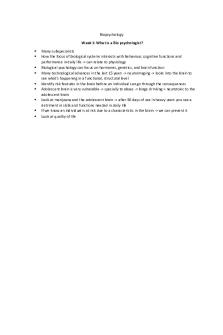
What is a Biopsychologist
- 1 Pages
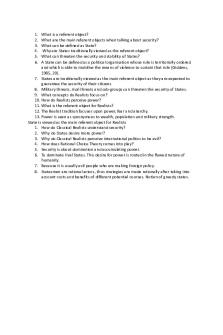
What is a referent object
- 1 Pages

What is a social fact
- 2 Pages

What is ABA - Grade: A
- 5 Pages

What is race - Grade: A
- 1 Pages
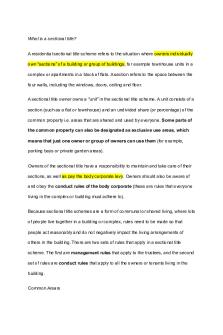
What is a sectional title
- 4 Pages

What is a product - lecture
- 4 Pages
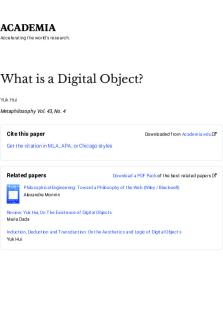
What is a Digital Object?
- 17 Pages

What is a ketogenic diet
- 2 Pages
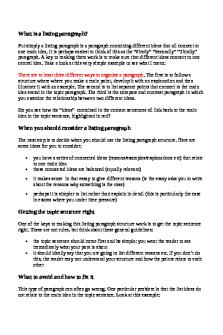
What is a listing paragraph
- 14 Pages

What is a Breadth Indicator
- 4 Pages
Popular Institutions
- Tinajero National High School - Annex
- Politeknik Caltex Riau
- Yokohama City University
- SGT University
- University of Al-Qadisiyah
- Divine Word College of Vigan
- Techniek College Rotterdam
- Universidade de Santiago
- Universiti Teknologi MARA Cawangan Johor Kampus Pasir Gudang
- Poltekkes Kemenkes Yogyakarta
- Baguio City National High School
- Colegio san marcos
- preparatoria uno
- Centro de Bachillerato Tecnológico Industrial y de Servicios No. 107
- Dalian Maritime University
- Quang Trung Secondary School
- Colegio Tecnológico en Informática
- Corporación Regional de Educación Superior
- Grupo CEDVA
- Dar Al Uloom University
- Centro de Estudios Preuniversitarios de la Universidad Nacional de Ingeniería
- 上智大学
- Aakash International School, Nuna Majara
- San Felipe Neri Catholic School
- Kang Chiao International School - New Taipei City
- Misamis Occidental National High School
- Institución Educativa Escuela Normal Juan Ladrilleros
- Kolehiyo ng Pantukan
- Batanes State College
- Instituto Continental
- Sekolah Menengah Kejuruan Kesehatan Kaltara (Tarakan)
- Colegio de La Inmaculada Concepcion - Cebu



